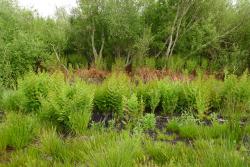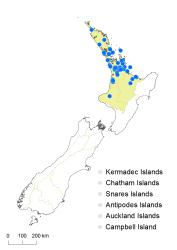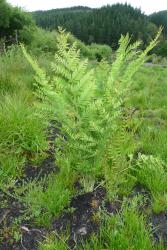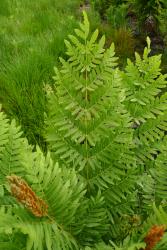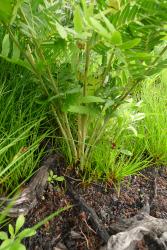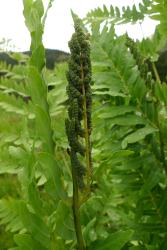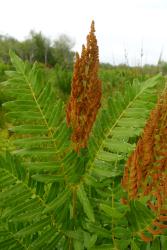- Taxon
- Weed
- Gallery
Rhizomes erect, forming woody trunks up to 1500 mm tall. Fronds 500–2070 mm long. Stipes 240–550 mm long, green turning yellow-brown with age, woolly hairy when young, becoming glabrous with age. Laminae 2-pinnate, or rarely 2-pinnate-pinnatifid, elliptic to obovate, 300–1700 mm long, 150–350 mm wide, rarely up to 2000 mm long and 750 mm wide, yellow-green, coriaceous, glabrous or hairy on costae; rachises green turning yellow-brown with age. Sterile primary pinnae on fertile fronds in 2–5, or rarely up to 9 pairs, elliptic, narrowly ovate or ovate; the longest at or about the middle, 180–330 mm long, 70–125 mm wide, often acroscopic at a narrow angle to the rachis. Fertile primary pinnae in distal half of lamina, in 5–10 pairs, up to 135 mm long, 45 mm wide. Sterile secondary pinnae oblong, narrowly oblong or ovate, 20–84 mm long, 8–19 mm wide, shortly stalked; apices acute; margins entire or minutely toothed, very occasionally deeply divided more than halfway to midrib; bases unequal, truncate to auriculate. Fertile secondary pinnae up to 30 mm long, 4 mm wide. Sporangia densely clustered on highly modified and reduced pinnae.
Osmunda regalis is immediately recognisable by its dimorphic fronds. On fertile fronds, the upper pinnae bear clusters of sporangia that completely replace the normal laminal tissue. No other species in New Zealand has such distinctively different fertile and sterile pinnae on the same frond except aberrant forms of Blechnum (especially B. novae-zelandiae).
North Island: Northland, Auckland, Volcanic Plateau, Taranaki.
Altitudinal range: 0–460 m
A sub-cosmopolitan species from Europe, western Asia, Africa, India and North and South America, first recorded in 1885 (without a voucher specimen) from the Rangitikei River by Field (1890) who suggested that spores may have been accidentally introduced from Europe with grass seed. It is no longer known from the Rangitikei, but is naturalised in scattered sites from Lake Waiparera, Aupouri District, to the Bay of Plenty and Rotorua, with isolated records south to Whangamomona, Taranaki. It is abundant in the Waikato and Hauraki Plains areas. It occurs most frequently in lowland sites, but there are isolated records up to 460 m in the Atiamuri district.
In swampy areas, wet ground, lake margins, streamsides and drains, under Salix, mānuka scrub or remnant Dacrycarpus dacrydioides forest; common in the Waikato Region where very large plants are well established in wet areas.
Field (1890, p. 145). Voucher: AK 259352, 1951.



